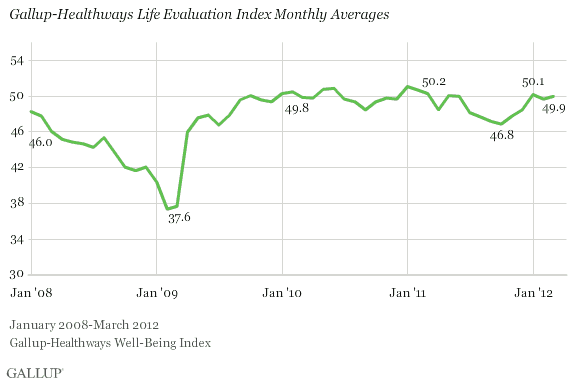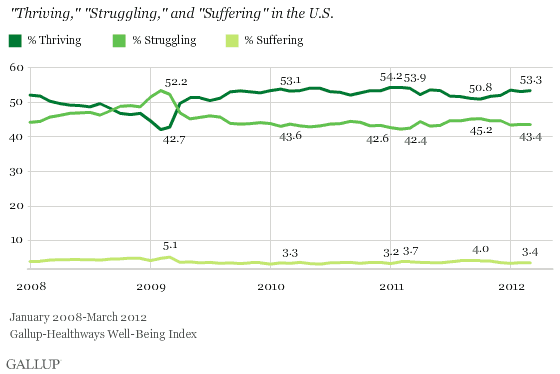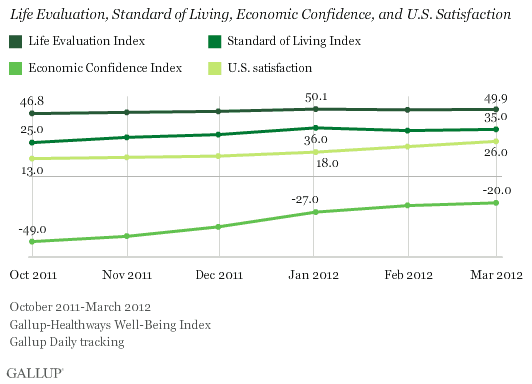WASHINGTON, D.C. -- Americans' Life Evaluation Index score of 49.9 in March continues the more positive trend seen in January (50.1) and February (49.6). These ratings are higher than they were in the final three months of 2011, including last October's Life Evaluation Index score of 46.8, which at the time was the lowest level in more than two years.

Americans' life ratings, which Gallup and Healthways started tracking daily in January 2008, started steadily improving in the winter, at about the same time that Americans' economic confidence and satisfaction with the way things are going in the U.S. began improving.
The Life Evaluation Index, part of the Gallup-Healthways Well-Being Index, classifies Americans as "thriving," "struggling," or "suffering" according to how they rate their current and future lives on a ladder scale with steps numbered from 0 to 10 based on the Cantril Self-Anchoring Striving Scale. The overall Life Evaluation Index score is calculated by subtracting the percentage of suffering Americans from the percentage of thriving Americans.
The percentage of Americans who rated their lives well enough to be classified as thriving was 53.3% in March, similar to the 53.0% in February. In March 2011, 53.9% of Americans were classified as thriving.
The percentage of Americans who were struggling in March, at 43.4%, was about on par with February. The percentage suffering also remained essentially unchanged at 3.4%, compared with 3.5% in February.

Life Ratings Continue to Mirror Standard of Living and U.S. Satisfaction Trends
The improvement in Americans' life ratings since October has tracked with their improving standard of living perceptions, satisfaction with the direction of the U.S., and economic confidence.

Gallup's Standard of Living Index score in March was the second highest since February 2011. Similarly, the Life Evaluation Index score in March was the second highest since June 2011. Both indexes had slightly higher scores in January, fell slightly in February, and increased again in March.
Bottom Line
Americans' life ratings increased steadily in the final months of 2011 and into January, and have held that higher level in February and now in March. These ratings coincide with growing confidence in the economy, rising U.S. satisfaction, and improving standard of living perceptions. The Gallup-Healthways Life Evaluation Index is at 49.9 in March, essentially the same as in February and January. Whether Americans' life ratings continue at this positive level in the future may hinge on what happens with the economic climate in the months ahead.
About the Gallup-Healthways Well-Being Index
The Gallup-Healthways Well-Being Index tracks well-being in the U.S., U.K., and Germany and provides best-in-class solutions for a healthier world. To learn more, please visit well-beingindex.com.
Survey Methods
Results are based on telephone interviews conducted as part of the Gallup-Healthways Well-Being Index survey March 1-31, 2012, with a random sample of 31,283 adults, aged 18 and older, living in all 50 U.S. states and the District of Columbia, selected using random-digit-dial sampling.
Life Evaluation Index figures from January 2008-April 2009 reflect re-estimates calculated to address context effects that Gallup discovered after originally publishing the data.
For results based on the total sample of national adults, one can say with 95% confidence that the maximum margin of sampling error is ±1 percentage point.
Interviews are conducted with respondents on landline telephones and cellular phones, with interviews conducted in Spanish for respondents who are primarily Spanish-speaking. Each sample includes a minimum quota of 400 cell phone respondents and 600 landline respondents per 1,000 national adults, with additional minimum quotas among landline respondents by region. Landline telephone numbers are chosen at random among listed telephone numbers. Cell phone numbers are selected using random-digit-dial methods. Landline respondents are chosen at random within each household on the basis of which member had the most recent birthday.
Samples are weighted by gender, age, race, Hispanic ethnicity, education, region, adults in the household, and phone status (cell phone only/landline only/both, cell phone mostly, and having an unlisted landline number). Demographic weighting targets are based on the March 2010 Current Population Survey figures for the aged 18 and older non-institutionalized population living in U.S. telephone households. All reported margins of sampling error include the computed design effects for weighting and sample design.
The Life Evaluation Index is based on the Cantril Self-Anchoring Striving Scale, which asks respondents to evaluate their present and future lives on a scale with steps numbered from 0 to 10, where "0" is the worst possible life and "10" is the best possible life. Those who rate today a "7" or higher and the future an "8" or higher are considered to be "thriving." Those who rate today and the future a "4" or lower on the scale are considered to be "suffering." The overall Life Evaluation Index score is calculated as the percentage of thriving Americans minus the percentage of suffering Americans.
In addition to sampling error, question wording and practical difficulties in conducting surveys can introduce error or bias into the findings of public opinion polls.
For more details on Gallup's polling methodology, visit www.gallup.com.
